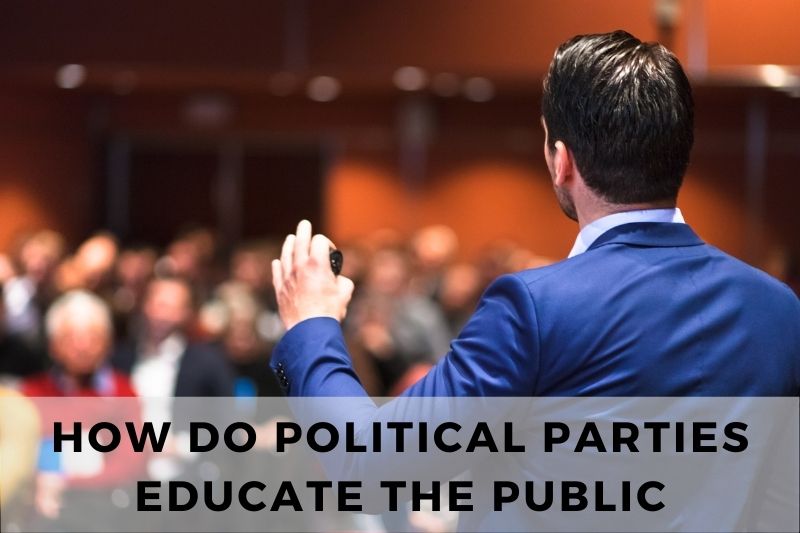
Political parties play a pivotal role in shaping the collective consciousness of a society. Their influence extends far beyond electoral cycles, as they serve as conduits for educating the public about political ideologies, policies, and candidates. Understanding how political parties engage in public education is essential for comprehending the dynamics of democratic processes.
In this article, we will dissect the traditional methods of political education employed by parties, delve into emerging digital strategies, and explore the significance of grassroots engagement and community outreach in fostering informed citizenry. Let’s embark on this journey of political enlightenment.
Traditional Methods of Political Education
#1. Party Manifestos and Platforms
Political parties elucidate their stances and policy agendas through manifestos and platforms. These documents outline their priorities, goals, and proposed solutions to societal issues. Manifestos serve as blueprints for governance, offering voters insight into the party’s vision for the future. They provide a comprehensive overview of the party’s stance on various issues, ranging from economy and healthcare to social and environmental policies.
#2. Campaign Speeches and Rallies
Campaign speeches and rallies serve as platforms for political leaders to articulate their messages directly to the public. Through impassioned rhetoric and persuasive appeals, candidates aim to garner support and rally voters behind their cause. These events offer opportunities for engagement and mobilization, shaping public opinion and swaying electoral outcomes. Rallies often energize supporters and create a sense of momentum around a campaign, fostering enthusiasm and voter turnout.
#3. Television and Radio Advertisements
Television and radio advertisements remain prominent tools for reaching mass audiences during political campaigns. Parties utilize these mediums with different political advertising techniques to broadcast their messages, highlight achievements, and discredit opponents. The visual and auditory impact of political advertisements can leave lasting impressions on voters, influencing their perceptions and voting behavior. Advertisements often employ emotive language, striking visuals, and memorable slogans to resonate with viewers and reinforce key campaign messages.
#4. Printed Materials
Printed materials, including pamphlets, flyers, and posters, are ubiquitous fixtures in political campaigns. Parties distribute these materials to disseminate information, promote candidates, and mobilize supporters. While the digital age has transformed communication channels, printed materials continue to play a role in reaching diverse demographics and bolstering grassroots efforts. They serve as tangible reminders of a party’s presence in the community and facilitate direct engagement with voters, particularly in areas with limited access to digital resources.
Digital Strategies for Political Education
#1. Social Media Campaigns
In today’s digital age, social media platforms have become indispensable tools for political education and outreach. Parties leverage platforms such as Facebook, Twitter, and Instagram to disseminate information, engage with voters, and mobilize supporters. Social media campaigns enable parties to reach broad demographics swiftly and efficiently, facilitating real-time interactions and fostering online communities.
#2. Online Videos and Podcasts
The proliferation of online video-sharing platforms and podcasts has revolutionized political communication. Parties produce videos and podcasts to convey their messages in engaging and accessible formats. These multimedia resources offer in-depth analyses, interviews with political leaders, and testimonials from constituents, providing voters with nuanced perspectives on key issues.
#3. Email Newsletters and Blogs
Email newsletters and blogs serve as channels for direct communication between political parties and their supporters. Parties send newsletters containing updates on campaign activities, policy announcements, and calls to action. Blogs offer platforms for party members and leaders to articulate their viewpoints, share insights, and engage in dialogue with readers. These digital mediums facilitate ongoing engagement and nurture relationships with constituents.
Grassroots Engagement and Community Outreach
#1. Door-to-door Campaigning
Door-to-door campaigning remains a cornerstone of grassroots engagement in political campaigns. Volunteers and party activists canvass neighborhoods to directly engage with voters, discuss key issues, and solicit support. This personalized approach allows parties to establish rapport with constituents, address their concerns, and mobilize grassroots support at the local level.
#2. Town Hall Meetings and Public Forums
Town hall meetings and public forums provide platforms for interactive dialogue between political representatives and constituents. These events offer opportunities for voters to voice their opinions, ask questions, and engage in meaningful discussions with elected officials and candidates. Town hall meetings foster transparency, accountability, and civic participation, enabling citizens to play an active role in shaping public policy and holding leaders accountable.
#3. Volunteer and Activist Networks
Volunteer and activist networks serve as the lifeblood of political campaigns, mobilizing grassroots support and driving voter turnout. Parties recruit volunteers to organize events, distribute campaign materials, and engage with voters on the ground. Activist networks amplify the party’s message through grassroots organizing, social media advocacy, and community outreach initiatives. By harnessing the energy and dedication of volunteers, parties can expand their reach and strengthen their presence in communities across the country.
Closing Thoughts
In the ever-evolving landscape of political education, parties employ a diverse array of strategies to inform, engage, and mobilize the public. From traditional methods such as manifestos and campaign speeches to digital platforms and grassroots initiatives, the goal remains constant: to foster an informed citizenry and uphold the principles of democracy. As we navigate the complexities of modern politics, it is imperative to recognize the importance of political education in shaping collective consciousness and driving societal progress. By embracing innovation, inclusivity, and civic engagement, political parties can empower citizens to participate actively in the democratic process and effect meaningful change.
